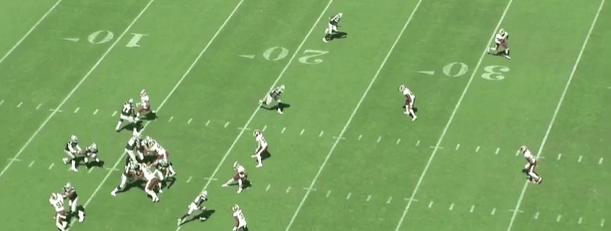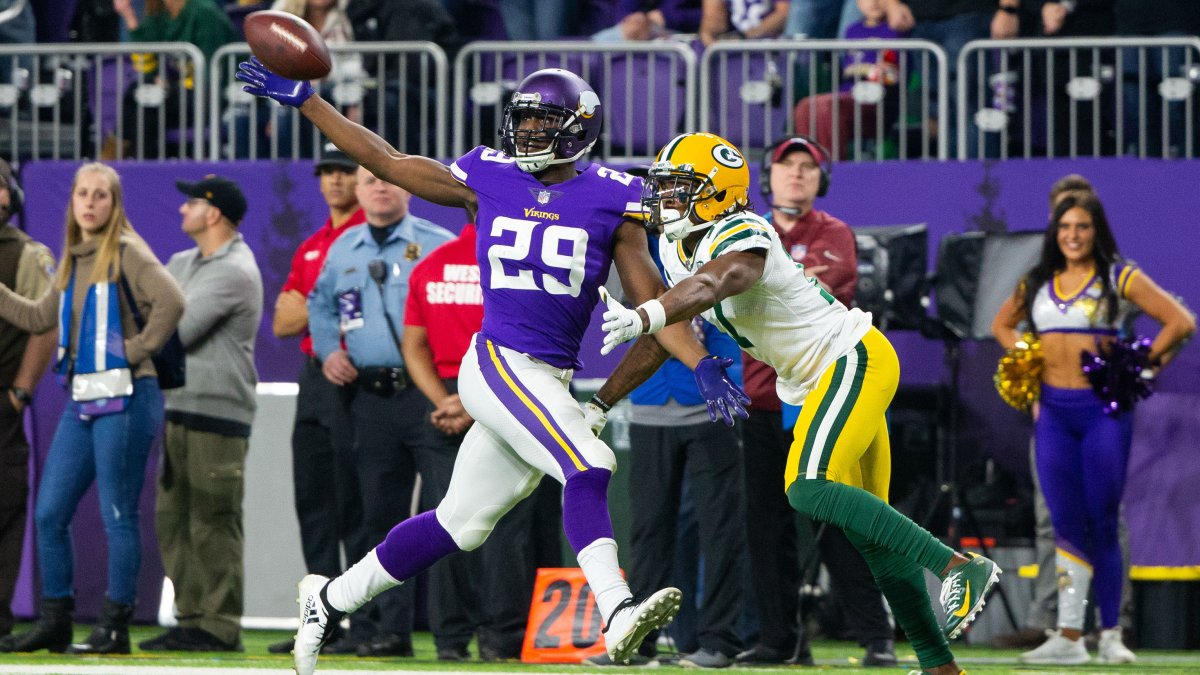When a team signs a big-name free agent or gives an extension to one of their home-grown stars, it’s easy to look past the potential ramifications of that deal down the line. Players regress, cap situations tighten, and once-solid deals start to be cast in a negative light. That’s where these 10 teams find themselves heading into 2020 – having to make decisions on veteran players who haven’t lived up to their contracts. The cap space that their teams stand to gain should these players be released paired with their recent performance makes each of them a prime candidate to be a cap casualty leading up to the 2020 season.
(Note: all salary cap data was taken from OverTheCap)
Sammy Watkins, WR, Kansas City Chiefs
2020 cap savings: $14 million
This one seems the least likely on the list, particularly after Watkins dropped a line of 7/114/1 in the Chiefs’ AFC Championship victory over the Tennessee Titans. The reality is, though, that the Chiefs could save $14 million against the cap by releasing Watkins this offseason. Since joining Kansas City, he ranks 48th among wide receivers in PFF WAR, sandwiched between Demaryius Thomas and the rookie Terry McLaurin, who took only one season to add as much value as Watkins has in two. After a Week 1 explosion in 2019, Watkins averaged just 1.11 receiving yards per route run, which ranked 76th out of 96 wide receivers with 250 or more routes run over that stretch.
With the receiving options the Chiefs already have on their roster and Mecole Hardman waiting in the wings for a larger role, taking the savings on Watkins and spreading them around the roster wouldn’t be the worst course of action for Kansas City.
Xavier Rhodes, CB, Minnesota Vikings
2020 cap savings: $8.1 million
It’s not too often that cutting a Pro Bowl cornerback is recommended, but Rhodes getting into the Pro Bowl this season is a minor miracle — or a joke, depending on how you choose to look at it. A side-by-side comparison of Rhodes’ numbers compared to his fellow Pro Bowlers does a pretty good job of painting that picture.
| NFC Pro Bowl Cornerback | Completion Rate Allowed | Passer Rating Allowed |
| Richard Sherman | 52.9% | 46.8 |
| Marshon Lattimore | 53.3% | 85.8 |
| Darius Slay | 58.3% | 86.9 |
| Jalen Ramsey | 67.2% | 96.4 |
| Kyle Fuller | 67.0% | 92.4 |
| Shaquill Griffin | 60.6% | 96.3 |
| Xavier Rhodes | 84.3% | 127.8 |
His decline began to rear its head in 2018, but this past season, it reached full-fledged free fall. 87 different cornerbacks saw 50 targets into their coverage in 2019, and none of them allowed a higher completion rate into their coverage than Rhodes did. His 84.3% completion rate allowed was the worst of that bunch by over 4%. Rhodes was never as dominant as the league-wide reputation that he commanded, but he regressed significantly to borderline unplayable this season. If the Vikings are unable to strike a trade, cutting Rhodes and pocketing the $8 million in cap space is the right move.
Marcell Dareus, DI, Jacksonville Jaguars
2020 cap savings: $20 million
Prior to this season, Dareus had played at least 400 snaps and graded above 75.0 each season since 2013. He has never really been a high-level pass-rusher, with a career-high pass-rushing grade of 72.5 coming all the way back in 2012, but he’s shown dominance as a run defender. A core muscle surgery placed him on injured reserve for much of this past season, but you still have to believe that he will come back and be productive in 2020.
The issue is that the Jaguars can save $20 million against the cap by cutting Dareus prior to June 1, and he simply isn’t worth that kind of money for a team that has one of the worst salary cap situations in the NFL. Paying good but not great interior defensive lineman over $20 million isn’t good business. Dareus as a cap casualty makes too much sense for him to still be on the roster in 2020.
Mark Barron, LB, Pittsburgh Steelers
2020 cap savings: $5.3 million
Somehow, Barron earned a reputation as the stereotypical coverage linebacker in the NFL without ever managing to have an elite season in coverage. Over his career, Barron’s career-high coverage grade came with the Los Angeles Rams at 72.3 in 2016, but that fell off to 65.2 in 2017, 54.4 in 2018, and 53.9 with the Steelers this past season. Previous playing experience at safety doesn’t automatically qualify a player for being an above-average coverage linebacker, and Barron is proof of that. He played 750 snaps for the Steelers in 2019, nearly doubling the snap total of last year’s starting linebacker Vince Williams. Williams played well in his limited role this season with an overall PFF grade of 76.2 that ranked 11th among qualifying linebackers.
With one of the lowest marks in projected cap space entering 2020, the Steelers need to look hard at several veterans that could save them some room with releases. Barron is at the top of that list with Devin Bush and Williams capable of holding down the linebacker position.
Jimmy Graham, TE, Green Bay Packers
2020 cap savings: $8 million
Graham tweeted out a cryptic message that hinted at a possible retirement, but with nothing concrete on his future yet, there’s still time to contemplate on what that future holds. From a financial perspective, it’s hard to see how the Packers can afford to keep Graham on his current contract in 2020.
Seeing Graham’s name atop the list of the highest-paid tight ends in the NFL is jarring. It’s been clear to anyone watching that this isn’t the same guy who was dunking on goal posts in New Orleans or making a real impact in his early years in Seattle. Since joining the Packers in 2018, Graham ranks 22nd among 25 tight ends who have played at least 1,000 offensive snaps in PFF overall grade. That lack of production makes parting ways with Graham the easy choice at his salary.
Josh Norman, CB, Washington Redskins
2020 cap savings: $12.5 million
When Norman signed his five-year, $75 million contract with the Redskins in the offseason prior to the 2016 season, this wasn’t the projected outcome. He was coming off a season with the Carolina Panthers in which he recorded an 89.9 coverage grade and allowed just over 50% of the passes into his coverage to be completed. That elite production never really followed Norman over from Carolina to Washington, and things took a nosedive in 2019 before he was ultimately benched with an overall grade of 45.6.

There were simply too many of these plays where Norman would get lost in coverage. That makes it hard to believe that Norman will be back in Washington next season with a $15.5 million cap hit that could be reduced to $3 million by releasing Norman prior to June 1. More likely than not, Norman will be looking to rebound on a less lucrative contract elsewhere.
Cordy Glenn, LT, Cincinnati Bengals
2020 cap savings: $9.5 million
Glenn was solid in limited action this season with a 68.4 overall grade in 291 snaps, and the Bengals’ offensive line could certainly use some more solid play. Glenn has recorded a pass-blocking grade of 70.0 or higher each season of his career since 2012, and though his run blocking has taken a dip in recent seasons with the Bengals, there is still reason to believe that Glenn could be a net-positive on an offensive line moving forward.
The issue with bringing him back in 2020 is that there were serious internal issues between Glenn and the Bengals coaching staff/front office that led to Glenn being fined $200,000 for conduct detrimental to the team. With the Bengals not being on the hook for any of his $9.5 million cap hit if he’s cut, chances are high that he won’t be back in a Bengals’ uniform.
Joe Flacco, QB, Denver Broncos
2020 cap savings: $10.1 million
Flacco was never going to be a long-term solution in Denver, but after trading a fourth-round pick for him this past offseason, the Broncos probably thought they would get more than eight weeks out of him before being sent to the bench with a neck injury that ultimately landed him on injured reserve. Now, it looks like his days as a starting NFL quarterback are numbered after five consecutive seasons in which he has failed to crack an overall grade of 75.0. With the future shifting to Drew Lock in a starting role in 2020, it makes little sense for Denver to keep Flacco around as a backup on his current contract. They’ll eat some money by releasing him, but the move would save them over $10 million towards the cap in 2020.
Janoris Jenkins, CB, New Orleans Saints
2020 cap savings: $11.3 million
Jenkins was already released once during the 2019 season by the New York Giants, where he spent over three years after beginning his career with the Rams. The Saints claimed Jenkins off waivers for their presumed postseason run, and Jenkins delivered with an 82.0 overall grade in three games played before the Saints were eliminated by the Vikings in an upset.
Jenkins has expressed interest in returning to the Saints next season, and if he plays at the level that he did to close the year, keeping Jenkins on makes some sense for a team that is poised to compete again. He finds his way onto this list, though, because he carries an $11.3 million cap hit with him that would become no money owed by the Saints if he were to be released. For a cornerback who hasn’t cracked a 70.0 coverage grade in a season since 2016, that might be tough to stomach for New Orleans. And in that case, Jenkins could find himself looking for another team in a few months.
Tyrone Crawford, DI, Dallas Cowboys
2020 cap savings: $8 million
There is no team that has more contract questions this offseason than the Cowboys. They need to find a way to retain three of PFF’s top 10 free agents this offseason – Dak Prescott, Amari Cooper, and Byron Jones – before you even get to other players like Maliek Collins who were key contributors this past season. That means that cap space will come at a premium to get all those deals done, and Crawford could be one of the victims.
He has been a fixture on the Cowboys’ defense, playing over 600 snaps each season from 2014 to 2018, but he was limited in 2019. Crawford was able to record just a 58.2 overall grade in 90 total defensive snaps after getting into legal issues and dealing with injuries in the offseason. With Crawford carrying a cap hit of over $9 million in 2020, he runs the risk of getting released if he and the Cowboys can’t re-negotiate his current contract.



 © 2024 PFF - all rights reserved.
© 2024 PFF - all rights reserved.